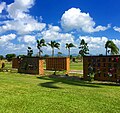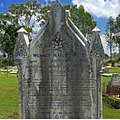Proserpine Cemetery
This article has multiple issues. Please help improve it or discuss these issues on the talk page. (Learn how and when to remove these messages)
|
| Proserpine Cemetery | |
|---|---|
 Proserpine Lawn Cemetery. | |
 | |
| Details | |
| Established | circa 1880. |
| Location | |
| Country | Australia |
| Coordinates | 20°23′41″S 148°33′50″E / 20.3948°S 148.5640°E |
| Type | Public |
| Website | [1] |
| Find a Grave | Proserpine Cemetery |
Proserpine Cemetery is a cemetery located in Proserpine a town in the Whitsunday Region of Queensland, Australia. It opened in the late 1880s and has seen the burials of many of the town's and region's pioneers. It is made up of two sections. The "Old" section was used from the late 1880s up until the 1980s and a "New" section which is the lawn cemetery that opened in the 1980s.
History
[edit]The Proserpine Cemetery commenced being used in the late 1880s and was placed under the control of the Proserpine Shire Council in the early 1900s.
Prior to this, there were many burials in isolated locations, and we have attempted to detail all of these. Regrettably, it will always be the case that some of these "lone graves" will never be located, but at least acknowledging that they did exist is most important.
In the early days of burials within Proserpine Cemetery, there was practically no order used in burials, apart from the segregation of the Catholics and Protestants. The weather apparently dictated the location of many burials. If the burial happened during the rainy season, it was in the northern part of the cemetery. When it was dry, it could be in the southern part.
Originally, the cemetery only contained two major sections. There was the Catholic Section (now detailed on maps known as Sections C-1 to C-8 inclusive), and the Protestant Section (now detailed on maps as Sections OP-1 to OP-11) inclusive.[citation needed]
For a long time, babies went wherever there was a space, and admittedly they didn't take much space, so were often squeezed in between other graves. Later certain sections were allocated for baby burials.It is quite notable that within the list of "Missing Graves" the incidence of children and babies is quite significant.
Regrettably, in the early days there was evidence of colour and racial prejudice when people of certain minority groups were buried "against the fence". The fence referred to here was that which used to be erected on the western side of the old Protestant side.
Unfortunately, this fence was removed when an extension of the cemetery area proved necessary and a road was constructed. This road services the New Protestant area (now detailed on maps as Sections NP-1 to NP-9 inclusive). It is almost certain that there are graves under this road.[citation needed]
In the days when suicides were looked on as shameful, there was pressure for such burials to be made "outside of the gates" and there is strong evidence to suggest that at least one such burial occurred. Certainly, in the list of "Missing Graves" there are several suicides. However, despite lengthy research, it has been impossible to determine which one of these people were buried outside the cemetery, and indeed where the actual burial took place.[1]
War graves
[edit]Proserpine Cemetery contains many war graves of Proserpine people who have served in all major wars.[citation needed]
Gallery
[edit]-
The Columbarium
-
The "Old" Section
-
Grave of Oliver Francis Ruge (d. 1930)
-
Grave of Werner Marcus Ruge (d. 1914)
-
Grave of Johan Frederick Phaff (d. 1907)
-
Grave of Charles & August Hyden (both d. 1911)
-
Grave of Metta Sophie (d. 1908)
-
Grave of William Greenwood
References
[edit]- ^ "History of the Whitsunday (Proserpine) Cemetery | Whitsunday Regional Council". www.whitsunday.qld.gov.au. Archived from the original on 30 March 2018. Retrieved 18 April 2018.








